Development and Evaluation from Laboratory to Field Trial of a Dual-Purpose Fracturing Nanofluid: Inhibition of Associated Formation Damage and Increasing Heavy Crude Oil Mobility
Abstract
:1. Introduction
2. Materials and Methods
2.1. Materials and Chemicals
2.2. Methods
2.2.1. Nanoparticle Surface Modification
2.2.2. Nanoparticle Characterization
2.2.3. Preparation of the Fracturing Fluids
2.2.4. Rheological Experiments
- The first kind of test related to low-pressure conditions was performed using a Kinexus Pro+ rotational rheometer (Malvern Instruments, Worcestershire, UK) with a Peltier plate for temperature control. At first, the viscosity changes in the HO induced by the presence of the nanoparticles were evaluated. In this case, a low (100 mg/L) and a high (1000 mg/L) concentration of these were mixed with the crude oil by stirring at 500 rpm for 30 min until homogenization [7]. The measures were made using a plate-plate geometry at a gap of 300 μm at 25 °C in a shear rate range of 1 to 100 s−1.
- Other tests at low pressure were carried out to determine if nanomaterials tend to aggregate in the presence of ZPM, as the proppant does. For this purpose, the LG was tested in the presence and absence of ZPM with or without the different nanoparticles at a concentration of 1000 mg/L. This set of rheological measurements was made with the geometry of the solid cylinders at 25 °C at a shear rate between 1 and 100 s−1. As mentioned above, the FF viscosity is one of the main properties of this kind of fluid due to its importance in placing the proppant in the open fracture according to the plan [27,33]. Hence, rheological measures were made to the original FF and samples of this when adding 100 and 1000 mg/L of the different nanoparticles. The solid cylinders geometry was used at the same temperature and fixed shear rates of 25, 50, 75 and 100 s−1. The purpose of this test is to emulate at low pressures and temperatures the first effort of the API RP39 test [34], the standard for evaluating the rheological properties of the fracturing fluids.
- Precisely, this is the third type of test, and a high pressure—high temperature Chandler 5550 viscometer (Chandler Engineering, Broken Arrow, USA) was used at the expected reservoir and fracking conditions 77 °C and 5500 psi. This procedure allows following the viscosity of the evaluated fracturing fluids when arming and through their rupture process under the action of shear rates of 25, 50, 75 and 100 s−1.
2.2.5. Wettability Alteration
2.2.6. Equilibrium Adsorption Isotherms of Polymer over the Rock Surface
2.2.7. Core-Flooding Tests
2.2.8. Field Trial in a Colombian Oilfield
2.3. Modelling
2.3.1. Rheological Model
2.3.2. SLE Model
3. Results
3.1. Nanoparticles Characterization and Selection of the Best according to Their Capacity of Enhancing HO Mobility
3.1.1. Nanoparticles Characterization
3.1.2. Crude Oil Viscosity Reduction
3.1.3. Nanoparticle Wettability Alteration
3.2. Static Tests of Adding Nanoparticles to a Commercial FF
3.2.1. Linear Gel
3.2.2. FF and Interactions Polymer-Nanoparticles
3.2.3. Optimized Fracturing Nanofluid
3.3. Dynamic Tests Made to Original FF and Optimized NanoFF
3.3.1. Proppant Media Tests
3.3.2. Formation Core Tests
3.4. Field Application in the Castilla Oil Field
4. Conclusions
Author Contributions
Funding
Institutional Review Board Statement
Informed Consent Statement
Data Availability Statement
Acknowledgments
Conflicts of Interest
References
- Cozzi, L.; Gould, T. World Energy Outlook 2015; International Energy Agency: Paris, France, 2015. [Google Scholar]
- Chew, K.J. The future of oil: Unconventional fossil fuels. Philos. Trans. R. Soc. Lond. A Math. Phys. Eng. Sci. 2014, 372, 20120324. [Google Scholar] [CrossRef] [PubMed]
- Hinkle, A.; Shin, E.-J.; Liberatore, M.W.; Herring, A.M.; Batzle, M. Correlating the chemical and physical properties of a set of heavy oils from around the world. Fuel 2008, 87, 3065–3070. [Google Scholar] [CrossRef]
- Meyer, R.F.; Attanasi, E. Heavy oil and natural bitumen: Strategic petroleum resources. World 2003, 434, 650–657. [Google Scholar]
- Ivory, J.; Chang, J.; Coates, R.; Forshner, K. Investigation of cyclic solvent injection process for heavy oil recovery. J. Can. Pet. Technol. 2009, 49, 22–33. [Google Scholar] [CrossRef]
- Firouz, Q.; Torabi, F. Feasibility Study of Solvent-Based Huff-N-Puff Method (Cyclic Solvent Injection) to Enhance Heavy Oil Recovery. In Proceedings of the SPE Heavy Oil Conference Canada, Calgary, AB, Canada, 12–14 June 2012; OnePetro: Richardson, TX, USA, 2012. [Google Scholar]
- Taborda, E.A.; Franco, C.A.; Lopera, S.H.; Alvarado, V.; Cortés, F.B. Effect of nanoparticles/nanofluids on the rheology of heavy crude oil and its mobility on porous media at reservoir conditions. Fuel 2016, 184, 222–232. [Google Scholar] [CrossRef]
- Li, Y.; Wang, Z.; Hu, Z.; Xu, B.; Li, Y.; Pu, W.; Zhao, J. A review of in situ upgrading technology for heavy crude oil. Petroleum 2021, 7, 117–122. [Google Scholar] [CrossRef]
- Cardona, L.; Medina, O.E.; Céspedes, S.; Lopera, S.H.; Cortés, F.B.; Franco, C.A. Effect of Steam Quality on Extra-Heavy Crude Oil Upgrading and Oil Recovery Assisted with PdO and NiO-Functionalized Al2O3 Nanoparticles. Processes 2021, 9, 1009. [Google Scholar] [CrossRef]
- Morte, M.K. Relative Permeability Determination for Steam Injection Processes: An Analytical Approach. Master’s Thesis, Texas A & M University, College Station, TX, USA, 2016. [Google Scholar]
- Pathak, V.; Babadagli, T.; Edmunds, N.R. Mechanics of Heavy Oil and Bitumen Recovery by Hot Solvent Injection. SPE Reserv. Eval. Eng. 2012, 15, 182–194. [Google Scholar] [CrossRef]
- Mohammed, M.A.; Babadagli, T. Experimental Investigation of Wettability Alteration in Oil-Wet Reservoirs Containing Heavy Oil. SPE Reserv. Eval. Eng. 2016, 19, 633–644. [Google Scholar] [CrossRef]
- Golabi, E.; Azad, F.S.; Ayatollahi, S.S.; Hosseini, S.; Akhlaghi, N. Experimental Study of Wettability Alteration of Limestone Rock from Oil-Wet to Water-Wet using Various Surfactants. In Proceedings of the SPE Heavy Oil Conference Canada, Calgary, AB, Canada, 12–14 June 2012. [Google Scholar]
- Bahamon, I.; Garcia, C.; Ulloa, M.; Leal, J.; Garay, R.; Medina, C.; Nieto, J. Successful Implementation of Hydraulic Fracturing Techniques in High Permeability Heavy Oil Wells in the Llanos Basin-Colombia. In Proceedings of the SPE Latin American and Caribbean Petroleum Engineering Conference, Quito, Ecuador, 18–20 November 2015; OnePetro: Richardson, TX, USA, 2015. [Google Scholar]
- Wang, M. Numerical Investigation of Water Loss Mechanisms during Hydraulic Fracturing Flow-Back Operation in Tight Oil Reservoirs. Master’s Thesis, University of Alberta, Edmonton, AB, Canada, 2016. [Google Scholar]
- You, L.; Xie, B.; Yang, J.; Kang, Y.; Han, H.; Wang, L.; Yang, B. Mechanism of fracture damage induced by fracturing fluid flowback in shale gas reservoirs. Nat. Gas. Ind. B 2019, 6, 366–373. [Google Scholar] [CrossRef]
- Bennetzen, M.V.; Mogensen, K. Novel Applications of Nanoparticles for Future Enhanced Oil Recovery. In Proceedings of the International Petroleum Technology Conference, Doha, Qatar, 19–22 January 2014. [Google Scholar]
- Martín-Palma, R.J.; Lakhtakia, A. Nanotechnology: A Crash Course; SPIE: Bellingham, WA, USA, 2010. [Google Scholar]
- Vakhin, A.V.; Khelkhal, M.A.; Mukhamatdinov, I.I.; Mukhamatdinova, R.E.; Tajik, A.; Slavkina, O.V.; Malaniy, S.Y.; Gafurov, M.R.; Nasybullin, A.R.; Morozov, O.G. Changes in Heavy Oil Saturates and Aromatics in the Presence of Microwave Radiation and Iron-Based Nanoparticles. Catalysts 2022, 12, 514. [Google Scholar] [CrossRef]
- Zabala, R.; Franco, C.A.; Cortés, F.B. Application of Nanofluids for Improving Oil Mobility in Heavy Oil and Extra-Heavy Oil: A Field Test. In Proceedings of the SPE Improved Oil Recovery Conference, Tulsa, OK, USA, 11–13 April 2016. [Google Scholar]
- Al-Maamari, R.S.H.; Buckley, J.S. Asphaltene Precipitation and Alteration of Wetting: The Potential for Wettability Changes During Oil Production. SPE Reserv. Eval. Eng. 2003, 6, 210–214. [Google Scholar] [CrossRef]
- Giraldo, J.; Benjumea, P.; Lopera, S.; Cortés, F.B.; Ruiz, M.A. Wettability Alteration of Sandstone Cores by Alumina-Based Nanofluids. Energy Fuels 2013, 27, 3659–3665. [Google Scholar] [CrossRef]
- Franco, C.A.; Nassar, N.N.; Ruiz, M.A.; Pereira-Almao, P.; Cortés, F.B. Nanoparticles for Inhibition of Asphaltenes Damage: Adsorption Study and Displacement Test on Porous Media. Energy Fuels 2013, 27, 2899–2907. [Google Scholar] [CrossRef]
- Betancur, S.; Carmona, J.C.; Nassar, N.N.; Franco, C.A.; Cortés, F.B. Role of Particle Size and Surface Acidity of Silica Gel Nanoparticles in Inhibition of Formation Damage by Asphaltene in Oil Reservoirs. Ind. Eng. Chem. Res. 2016, 55, 6122–6132. [Google Scholar] [CrossRef]
- Zhang, H.; Nikolov, A.; Wasan, D. Enhanced Oil Recovery (EOR) Using Nanoparticle Dispersions: Underlying Mechanism and Imbibition Experiments. Energy Fuels 2014, 28, 3002–3009. [Google Scholar] [CrossRef]
- Liang, F.; Al-Muntasheri, G.; Ow, H.; Cox, J. Reduced Polymer Loading, High Temperature Fracturing Fluids using Nano-crosslinkers. In Proceedings of the Abu Dhabi International Petroleum Exhibition and Conference, Abu Dhabi, United Arab Emirates, 9–12 November 2015. [Google Scholar]
- Guzmán, J.D.; Pineda, D.; Franco, C.A.; Botero, F.; Lopera, S.H.; Cortés, F.B. Effect of nanoparticle inclusion in fracturing fluids applied to tight gas-condensate reservoirs: Reduction of Methanol loading and the associated formation damage. J. Nat. Gas. Sci. Eng. 2017, 40, 347–355. [Google Scholar] [CrossRef]
- Huang, T.; Crews, J.B. Nanotechnology applications in viscoelastic surfactant stimulation fluids. SPE Prod. Oper. 2008, 23, 512–517. [Google Scholar] [CrossRef]
- Huang, T.; Crews, J.B.; Agrawal, G. Nanoparticle Pseudocrosslinked Micellar Fluids: Optimal Solution for Fluid-Loss Control With Internal Breaking. In Proceedings of the SPE International Symposium and Exhibition on Formation Damage Control, Lafayette, LA, USA, 10–12 February 2010. [Google Scholar]
- Lafitte, V.; Tustin, G.; Drochon, B.; Parris, M. Nanomaterials in Fracturing Applications (SPE 155533). In Proceedings of the SPE International Oilfield Nanotechnology Conference, Noordwijk, The Netherlands, 12–14 June 2012. [Google Scholar]
- Franco-Ariza, C.A.; Guzmán-Calle, J.D.; Cortés, F.B. Adsorption and catalytic oxidation of asphaltenes in fumed silica nanoparticles: Effect of the surface acidity. DYNA 2016, 83, 171. [Google Scholar] [CrossRef]
- Brunauer, S.; Emmett, P.H.; Teller, E. Adsorption of Gases in Multimolecular Layers. J. Am. Chem. Soc. 1938, 60, 309–319. [Google Scholar] [CrossRef]
- Fink, J. Hydraulic Fracturing Chemicals and Fluids Technology; Gulf Professional Publishing: Houston, TX, USA, 2013. [Google Scholar]
- Api, R. Recommended Practice on Measuring the Viscous Properties of a Crosslinked Water-Based Fracturing Fluid; American Petroleum Institute: Washington, DC, USA, 1998. [Google Scholar]
- Guzmán, J.D.; Betancur, S.; Carrasco-Marín, F.; Franco, C.A.; Nassar, N.N.; Cortés, F.B. Importance of the Adsorption Method Used for Obtaining the Nanoparticle Dosage for Asphaltene-Related Treatments. Energy Fuels 2016, 30, 2052–2059. [Google Scholar] [CrossRef]
- Giraldo, L.J.; Giraldo, M.A.; Llanos, S.; Maya, G.; Zabala, R.D.; Nassar, N.N.; Franco, C.A.; Alvarado, V.; Cortés, F.B. The effects of SiO2 nanoparticles on the thermal stability and rheological behavior of hydrolyzed polyacrylamide based polymeric solutions. J. Pet. Sci. Eng. 2017, 159, 841–852. [Google Scholar] [CrossRef]
- Greenspan, L. Humidity fixed points of binary saturated aqueous solutions. J. Res. Natl. Bur. Stand. 1977, 81, 89–96. [Google Scholar] [CrossRef]
- Franco, C.A.; Giraldo, L.J.; Candela, C.H.; Bernal, K.M.; Villamil, F.; Montes, D.; Lopera, S.H.; Franco, C.A.; Cortés, F.B. Design and tuning of nanofluids applied to chemical enhanced oil recovery based on the surfactant–nanoparticle–brine interaction: From laboratory experiments to oil field application. Nanomaterials 2020, 10, 1579. [Google Scholar] [CrossRef]
- Tao, T.M.; Watson, A.T. Accuracy of JBN Estimates of Relative Permeability: Part 1—Error Analysis. Soc. Pet. Eng. J. 1984, 24, 209–214. [Google Scholar] [CrossRef]
- Tao, T.M.; Watson, A.T. Accuracy of JBN Estimates of Relative Permeability: Part 2—Algorithms. Soc. Pet. Eng. J. 1984, 24, 215–223. [Google Scholar] [CrossRef]
- Nik, W.W.; Ani, F.N.; Masjuki, H.; Giap, S.E. Rheology of bio-edible oils according to several rheological models and its potential as hydraulic fluid. Ind. Crop. Prod. 2005, 22, 249–255. [Google Scholar] [CrossRef]
- Nassar, N.N.; Betancur, S.; Acevedo, S.C.; Franco, C.A.; Cortés, F.B. Development of a Population Balance Model to Describe the Influence of Shear and Nanoparticles on the Aggregation and Fragmentation of Asphaltene Aggregates. Ind. Eng. Chem. Res. 2015, 54, 8201–8211. [Google Scholar] [CrossRef]
- Montgomery, D.C. Design and Analysis of Experiments; John Wiley & Sons: New York, NY, USA, 2017. [Google Scholar]
- Montoya, T.; Coral, D.; Franco, C.A.; Nassar, N.N.; Cortés, F.B. A Novel Solid–Liquid Equilibrium Model for Describing the Adsorption of Associating Asphaltene Molecules onto Solid Surfaces Based on the “Chemical Theory”. Energy Fuels 2014, 28, 4963–4975. [Google Scholar] [CrossRef]
- Talu, O.; Meunier, F. Adsorption of associating molecules in micropores and application to water on carbon. AIChE J. 1996, 42, 809–819. [Google Scholar] [CrossRef]
- Mortazavi-Manesh, S.; Shaw, J.M. Thixotropic Rheological Behavior of Maya Crude Oil. Energy Fuels 2014, 28, 972–979. [Google Scholar] [CrossRef]
- Adams, J.J. Asphaltene adsorption, a literature review. Energy Fuels 2014, 28, 2831–2856. [Google Scholar] [CrossRef]
- Taborda, E.A.; Franco, C.A.; Ruiz, M.A.; Alvarado, V.; Cortés, F.B. Experimental and Theoretical Study of Viscosity Reduction in Heavy Crude Oils by Addition of Nanoparticles. Energy Fuels 2017, 31, 1329–1338. [Google Scholar] [CrossRef]
- Al-Zahrani, S.M. A generalized rheological model for shear thinning fluids. J. Pet. Sci. Eng. 1997, 17, 211–215. [Google Scholar] [CrossRef]
- Song, K.-W.; Kim, Y.-S.; Chang, G.-S. Rheology of concentrated xanthan gum solutions: Steady shear flow behavior. Fibers Polym. 2006, 7, 129–138. [Google Scholar] [CrossRef]
- Laguna, M.T.R.; Tarazona, M.P.; Saiz, E. The use of molecular dynamics for the study of solution properties of guar gum. J. Chem. Phys. 2003, 119, 1148–1156. [Google Scholar] [CrossRef]
- Thommes, M.; Kaneko, K.; Neimark, A.V.; Olivier, J.P.; Rodriguez-Reinoso, F.; Rouquerol, J.; Sing, K.S.W. Physisorption of Gases, With Special Reference to the Evaluation of Surface Area and Pore Size Distribution (IUPAC Technical Report). Pure Appl. Chem. 2015, 87, 1051–1069. [Google Scholar] [CrossRef] [Green Version]
- Li, Y.; Wang, S.; Guo, J.; Chen, R.; Zhao, F.; Liu, Y. Reducing adsorption of hydroxypropyl guar gum on sandstone by silicon nanoparticles. Carbohydr. Polym. 2019, 219, 21–28. [Google Scholar] [CrossRef]
- Giraldo, L.J.; Gallego, J.; Villegas, J.P.; Franco, C.A.; Cortés, F.B. Enhanced waterflooding with NiO/SiO2 0-D Janus nanoparticles at low concentration. J. Pet. Sci. Eng. 2018, 174, 40–48. [Google Scholar] [CrossRef]
- Li, S.; Torsaeter, O. The Impact of Nanoparticles Adsorption and Transport on Wettability Alteration of Intermediate Wet Berea Sandstone. In Proceedings of the SPE Middle East Unconventional Resources Conference and Exhibition, Muscat, Oman, 26–28 January 2015. [Google Scholar]
- Yudin, I.K.; Anisimov, M.A. Dynamic Light Scattering Monitoring of Asphaltene Aggregation in Crude Oils and Hydrocarbon Solutions. In Asphaltenes, Heavy Oils, and Petroleomics; Springer: New York, NY, USA, 2007; pp. 439–468. [Google Scholar]
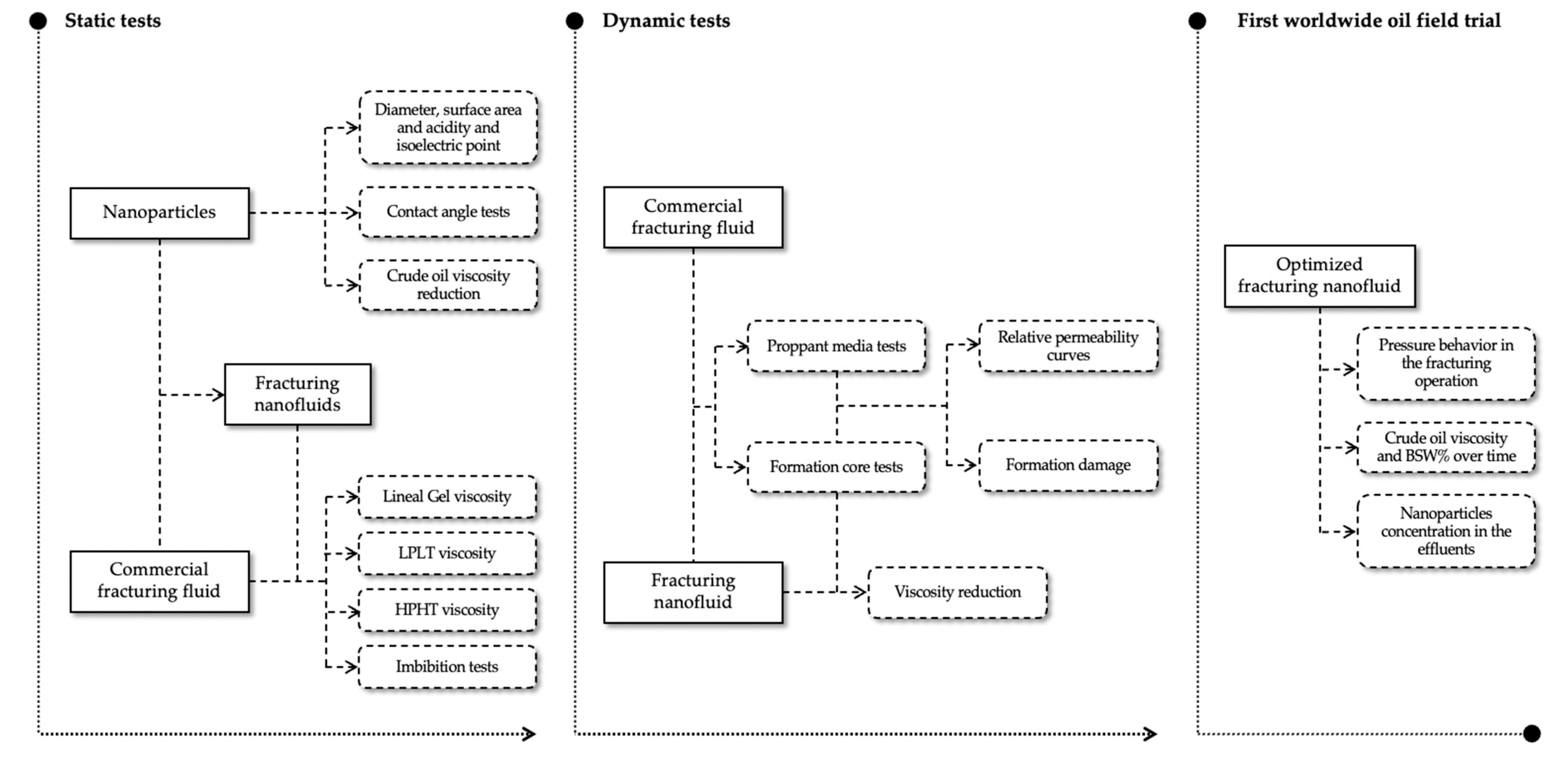



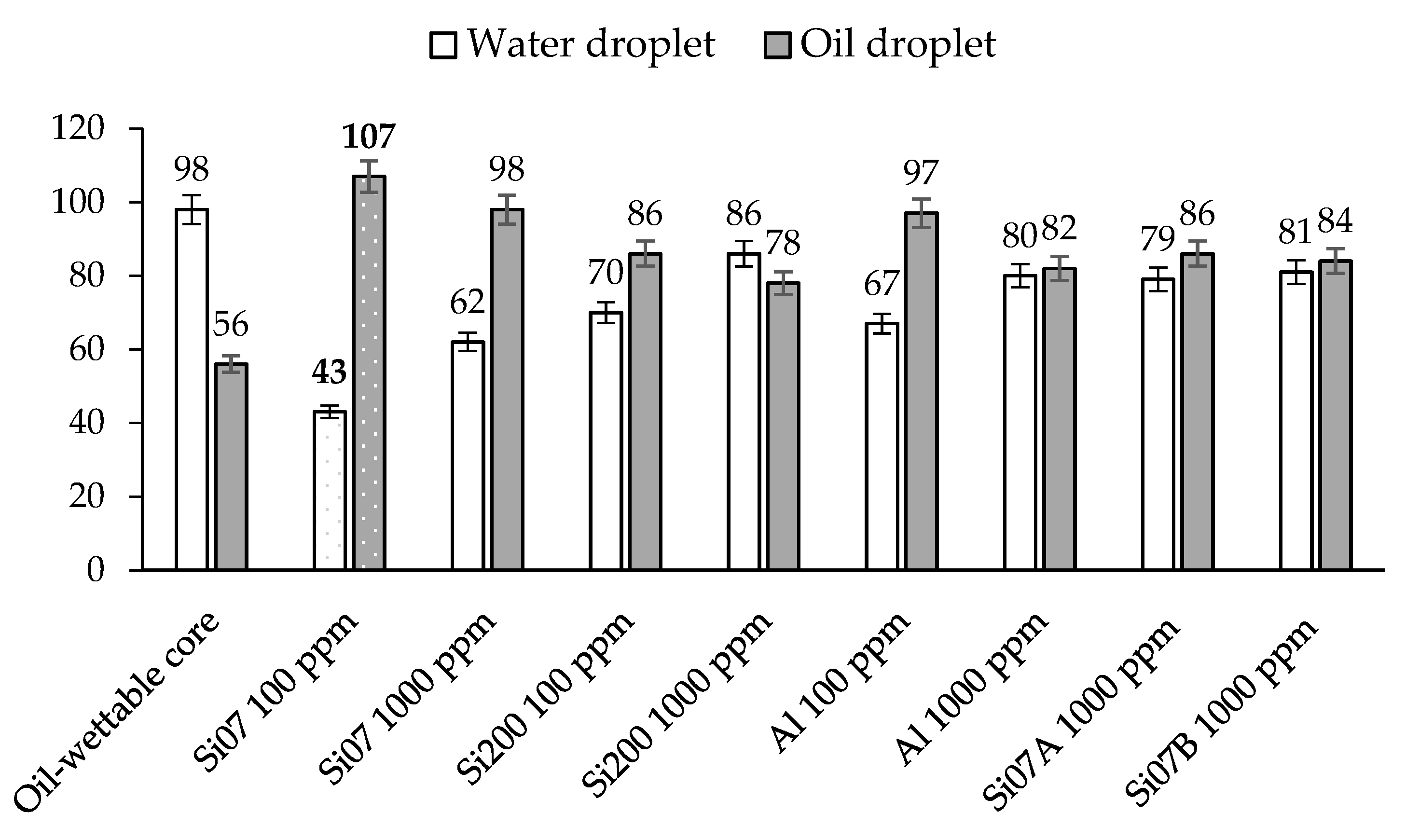
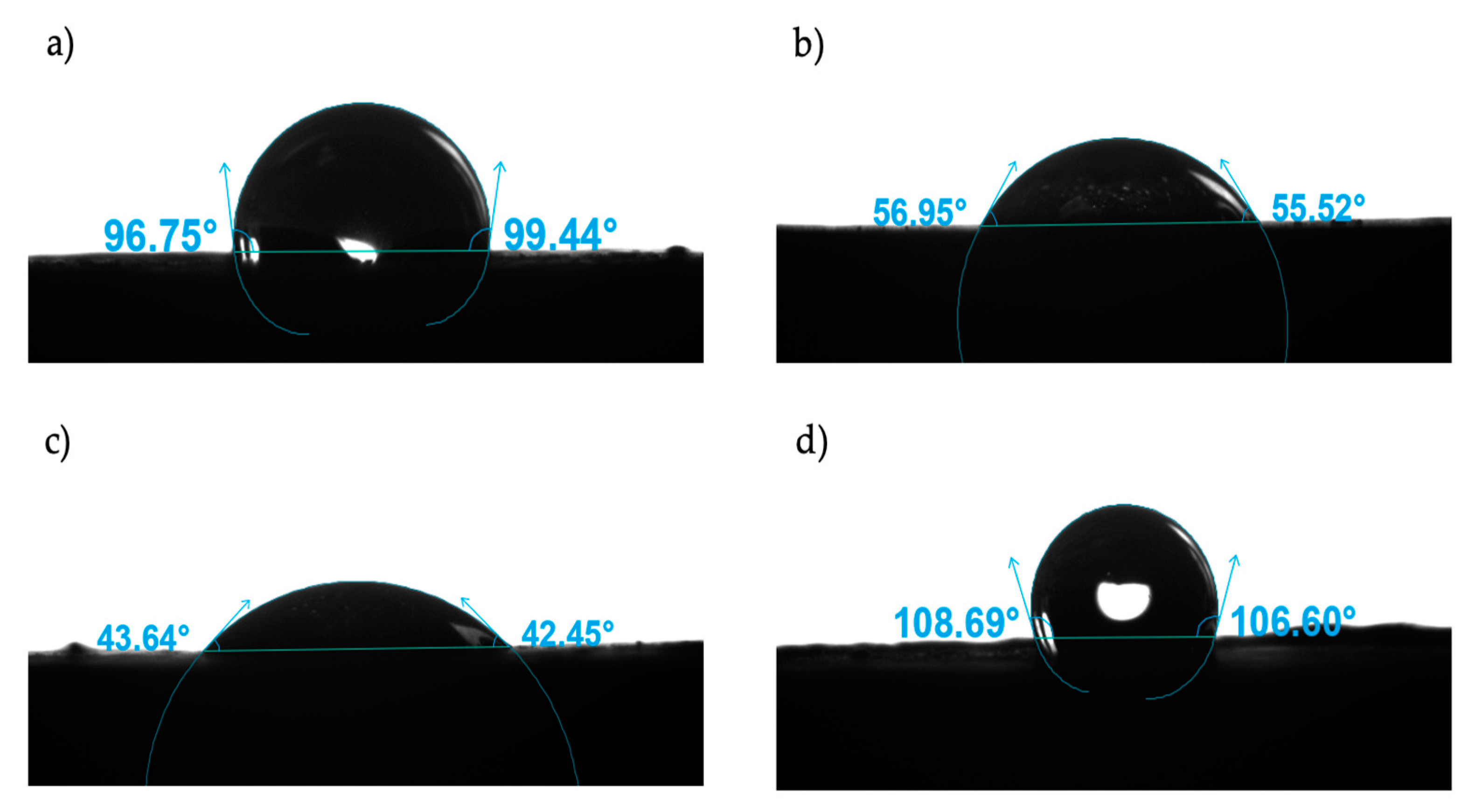
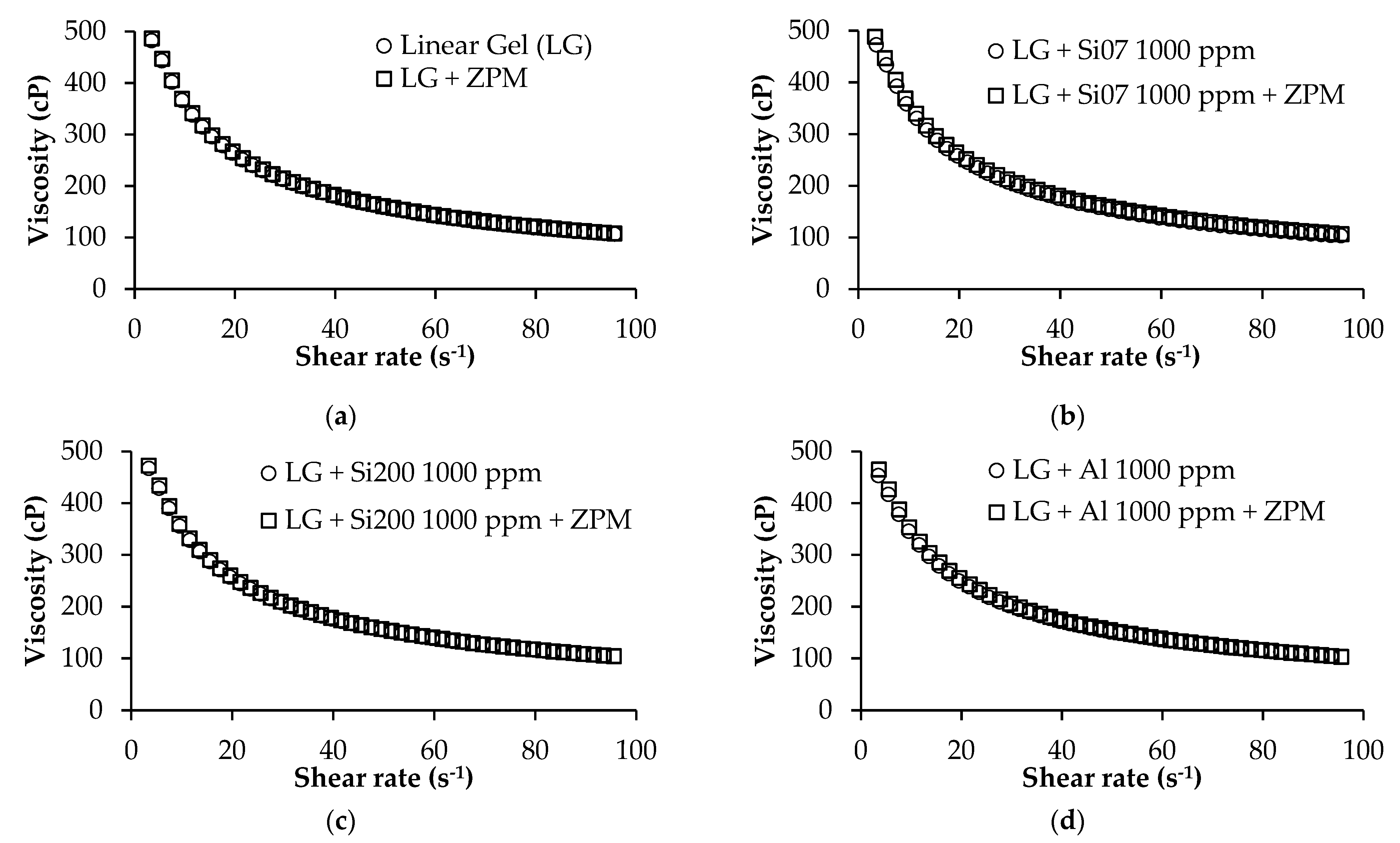
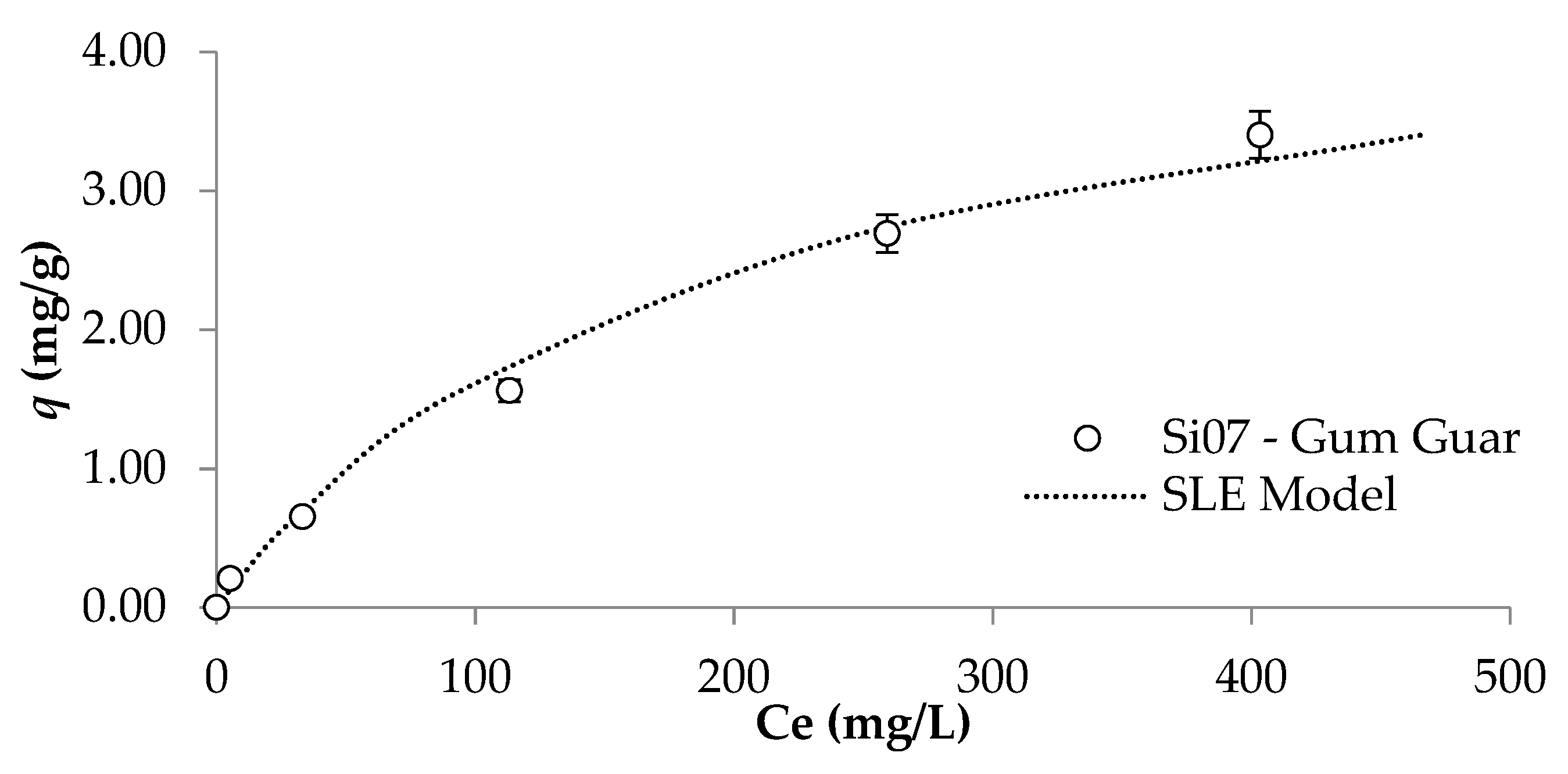
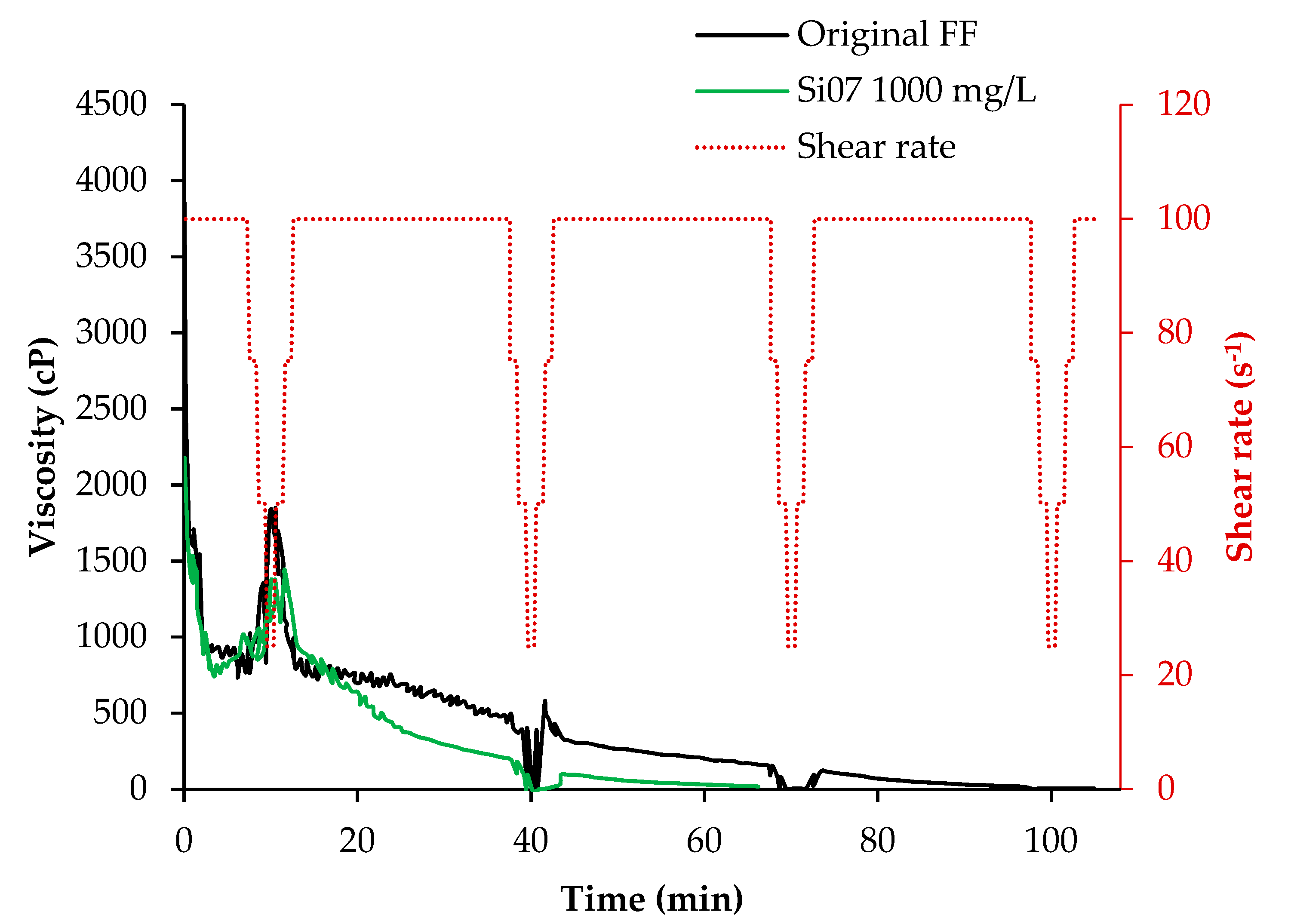

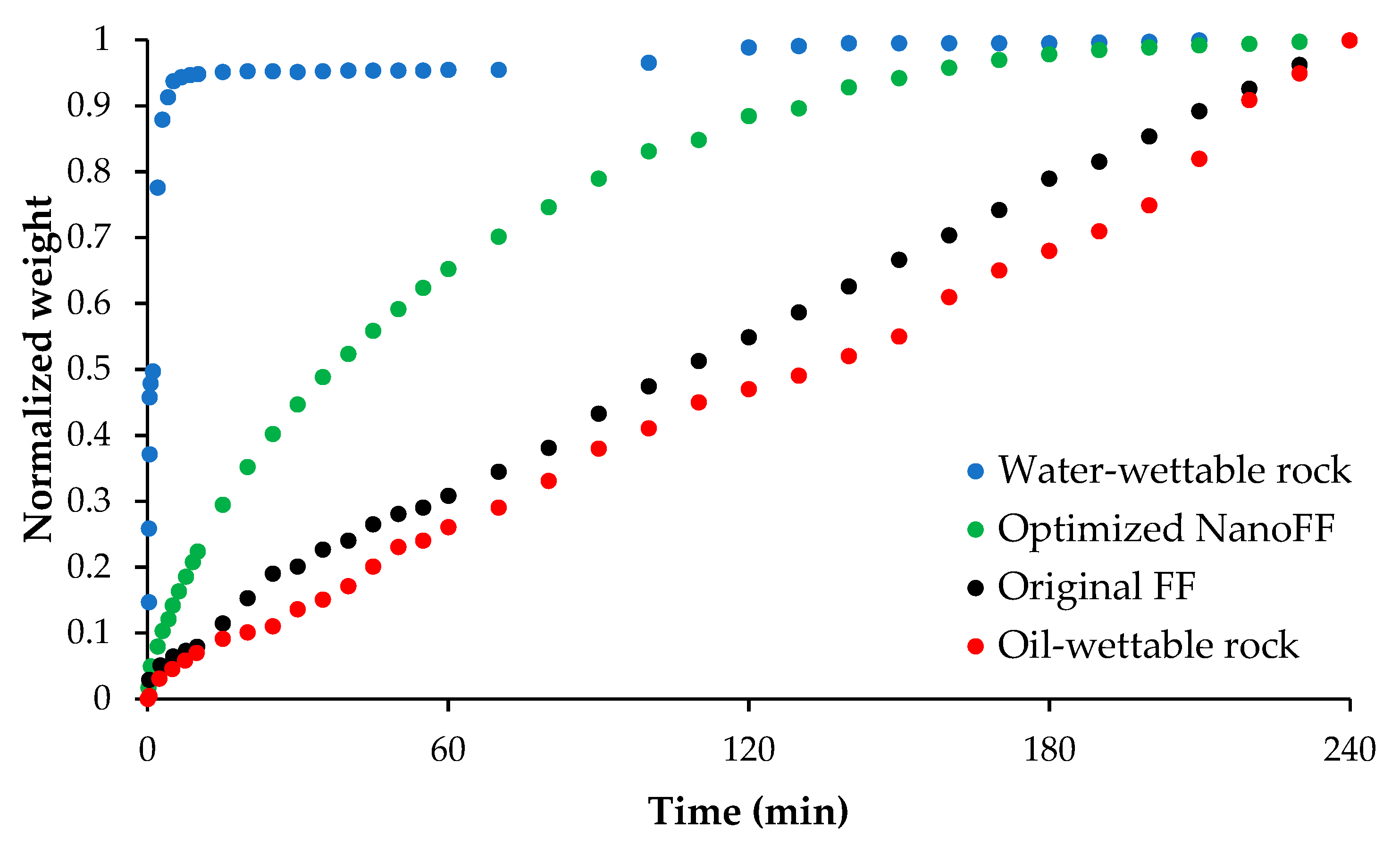
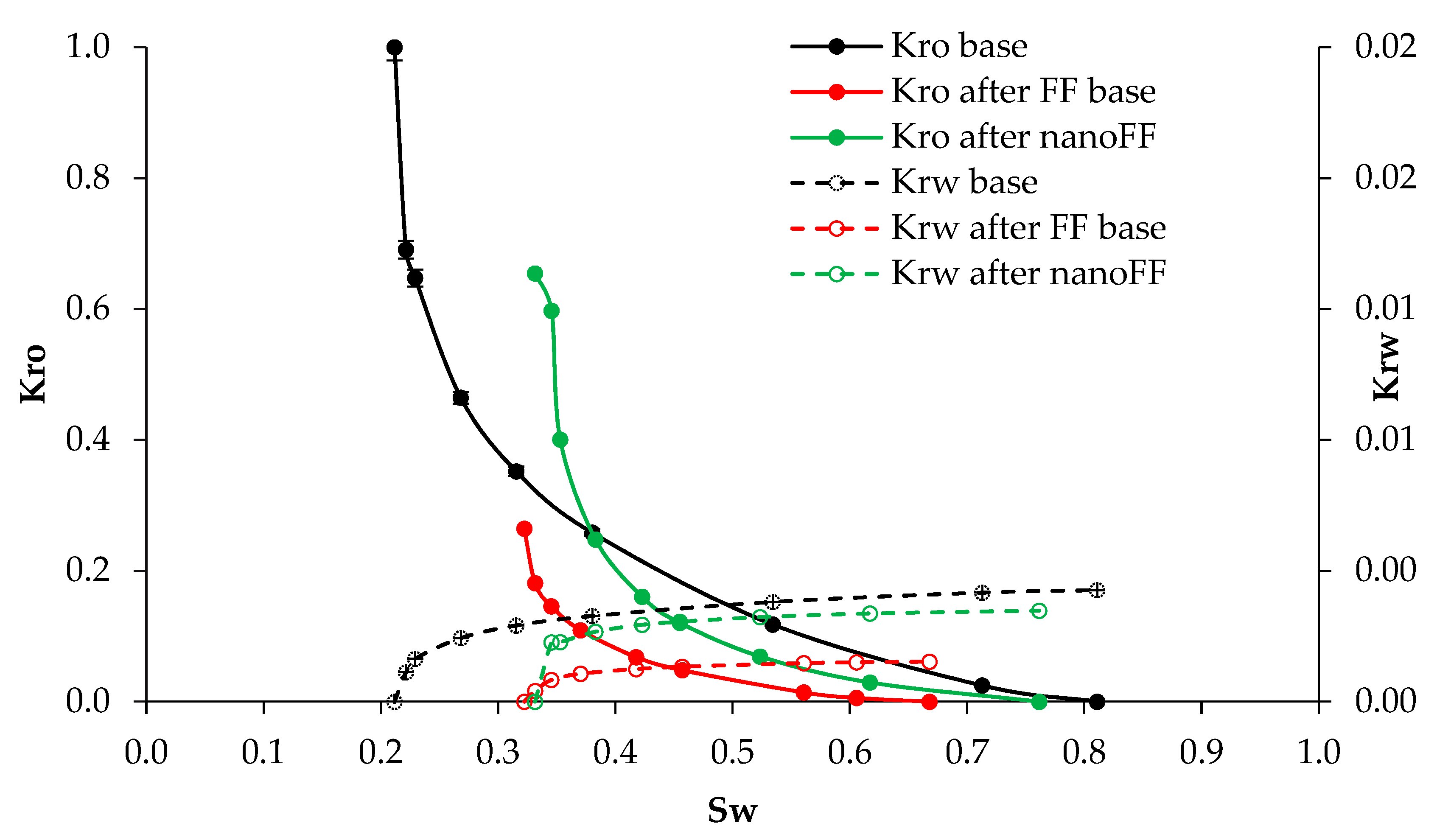
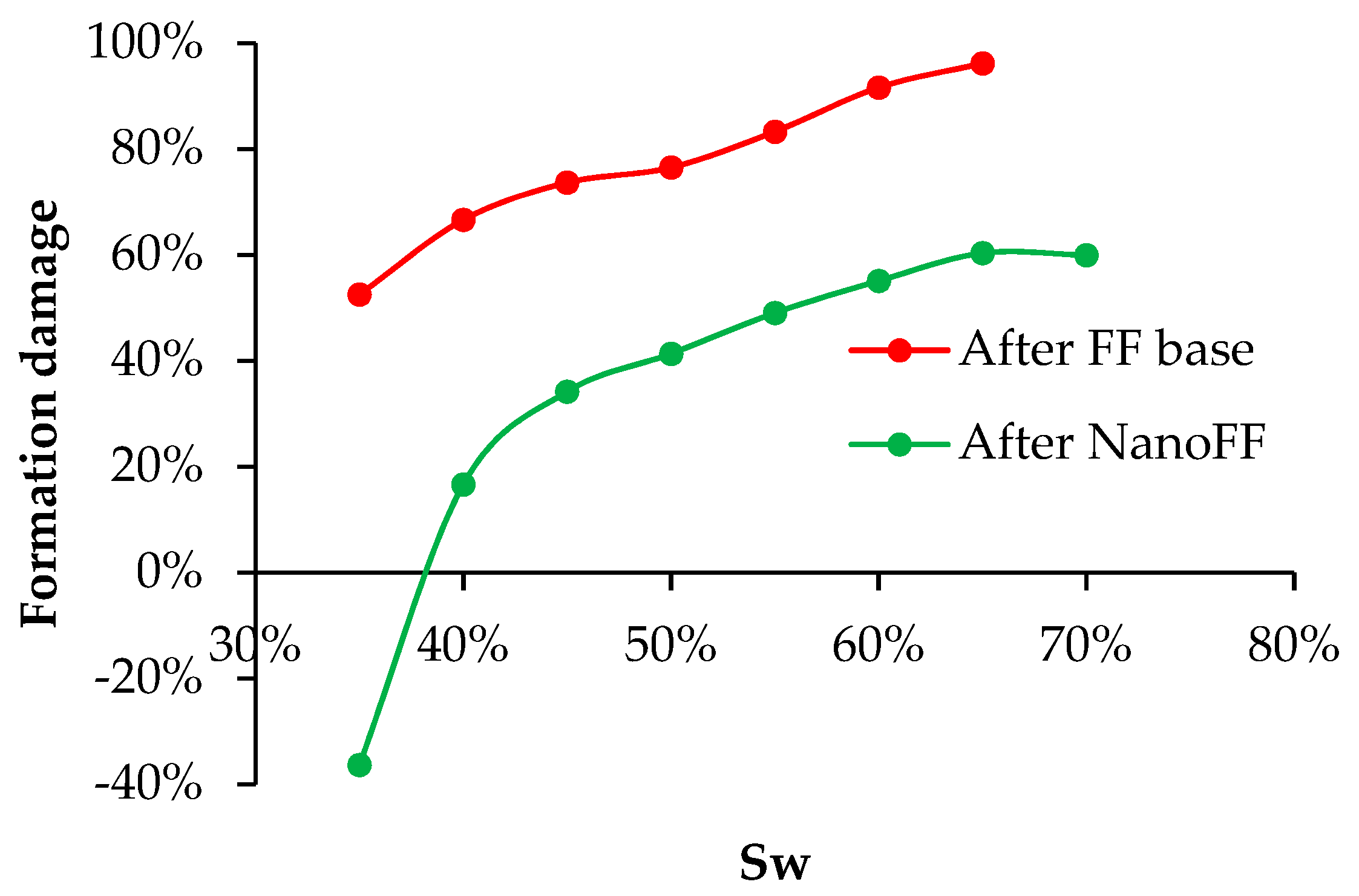
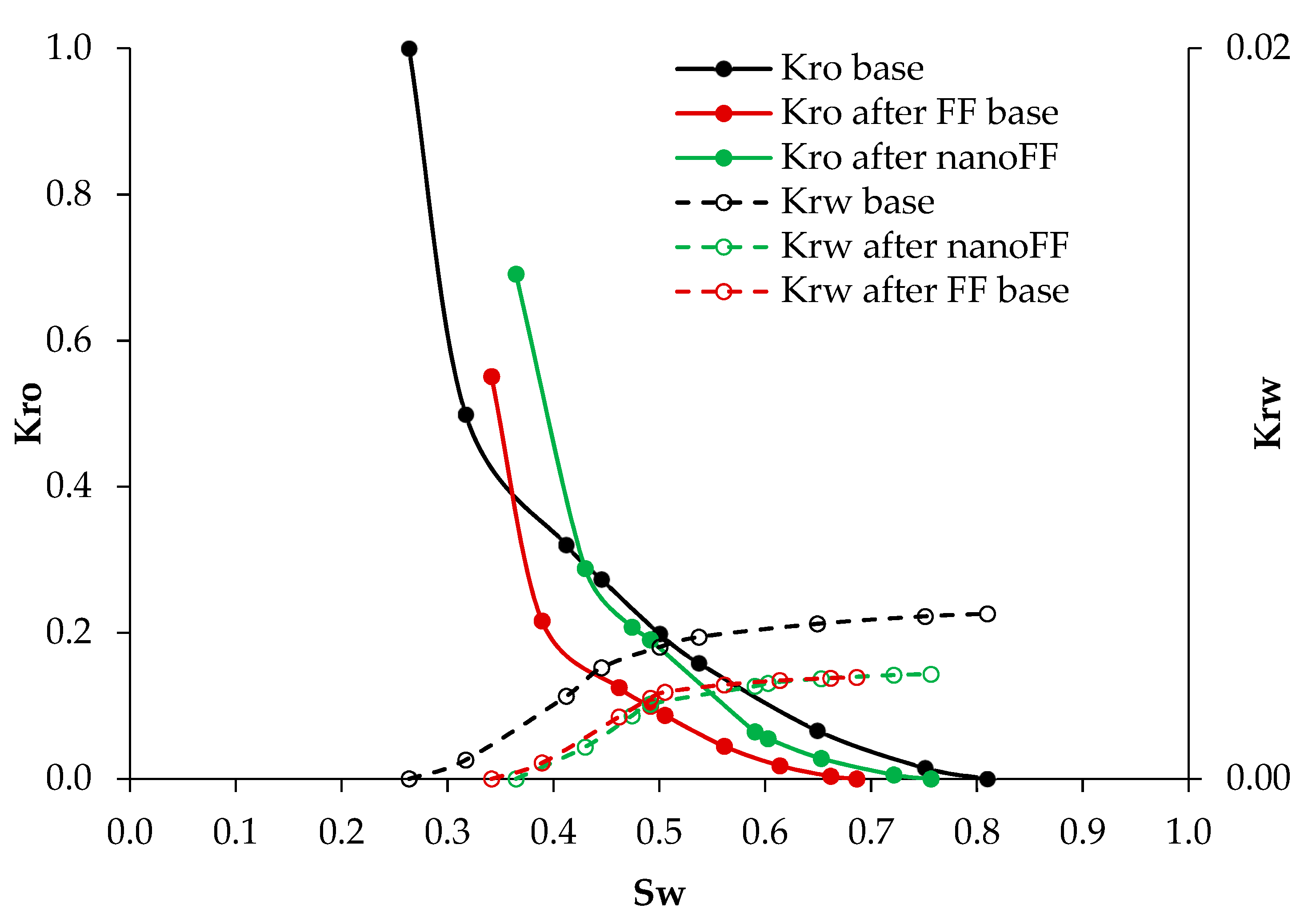
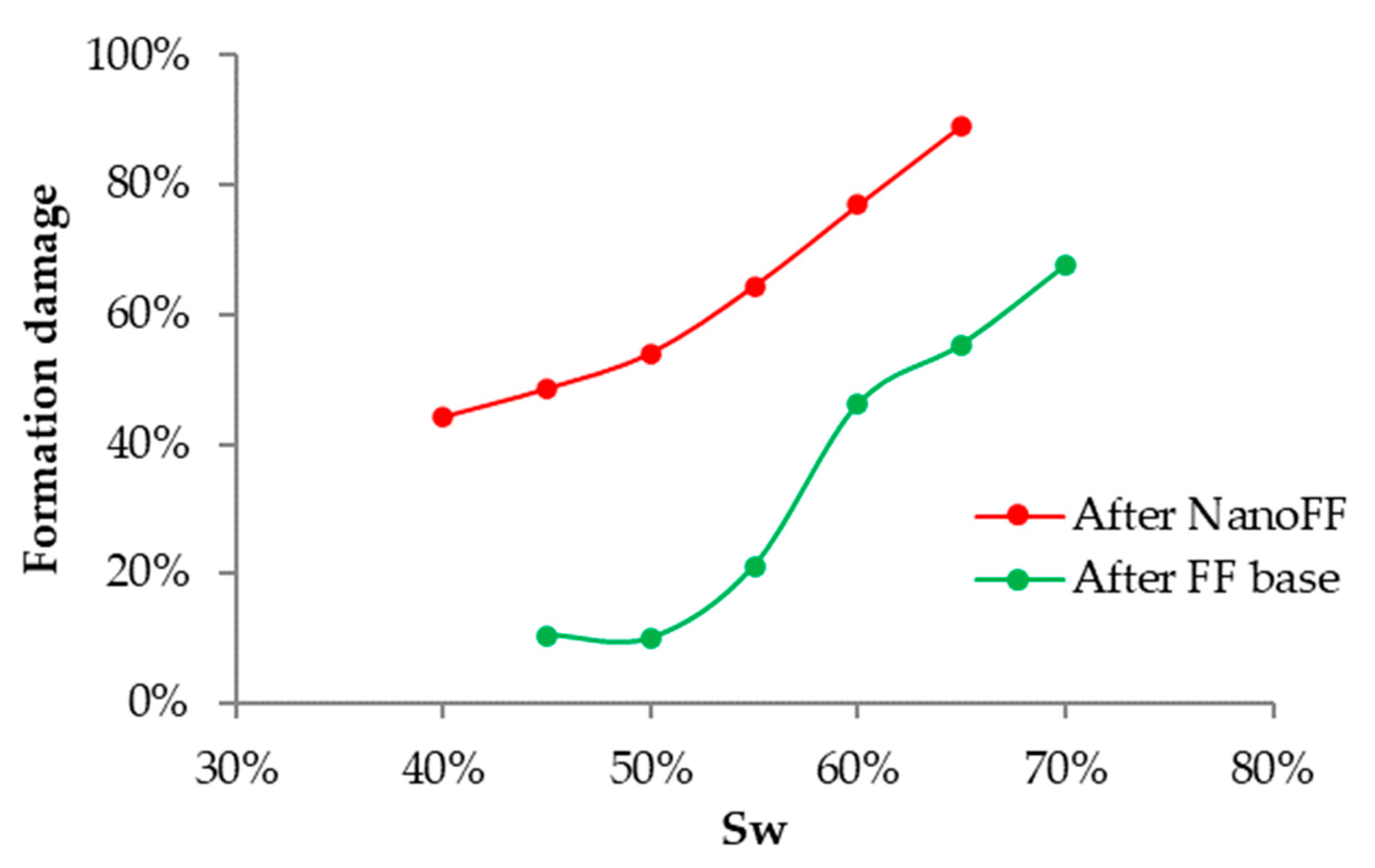

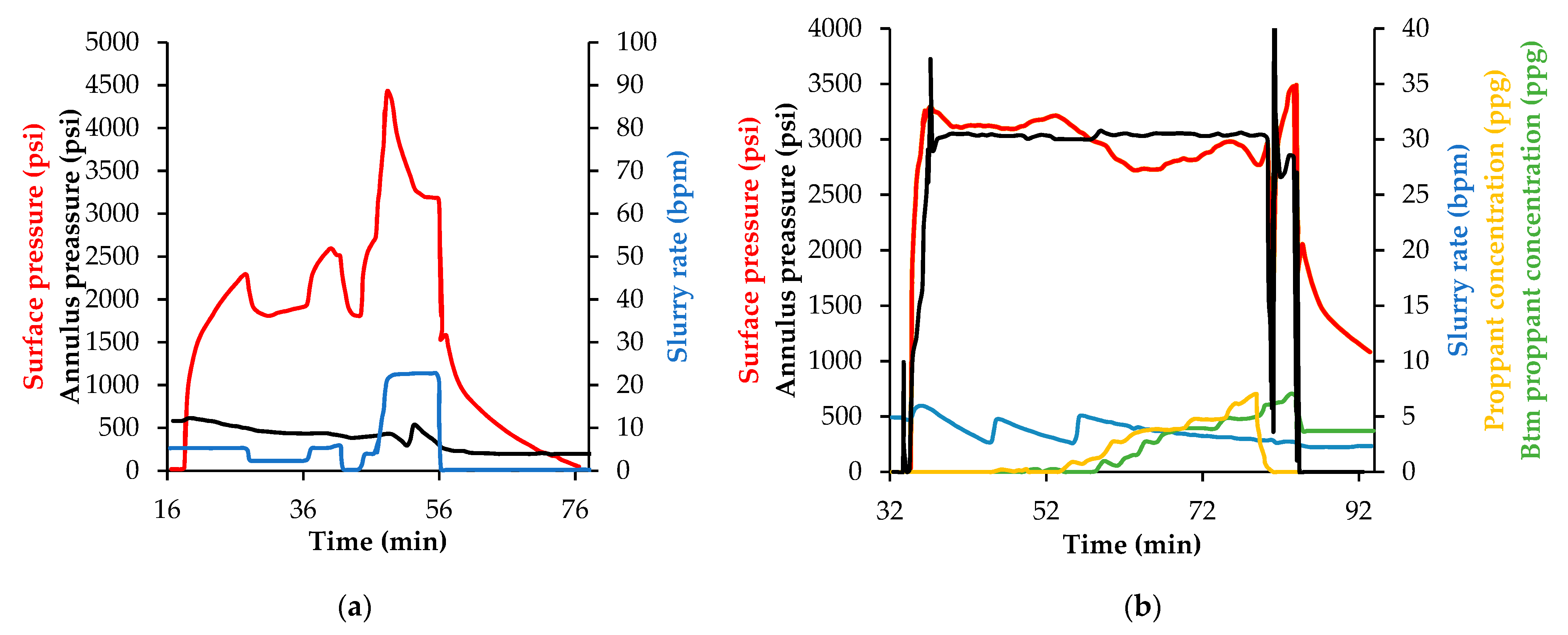
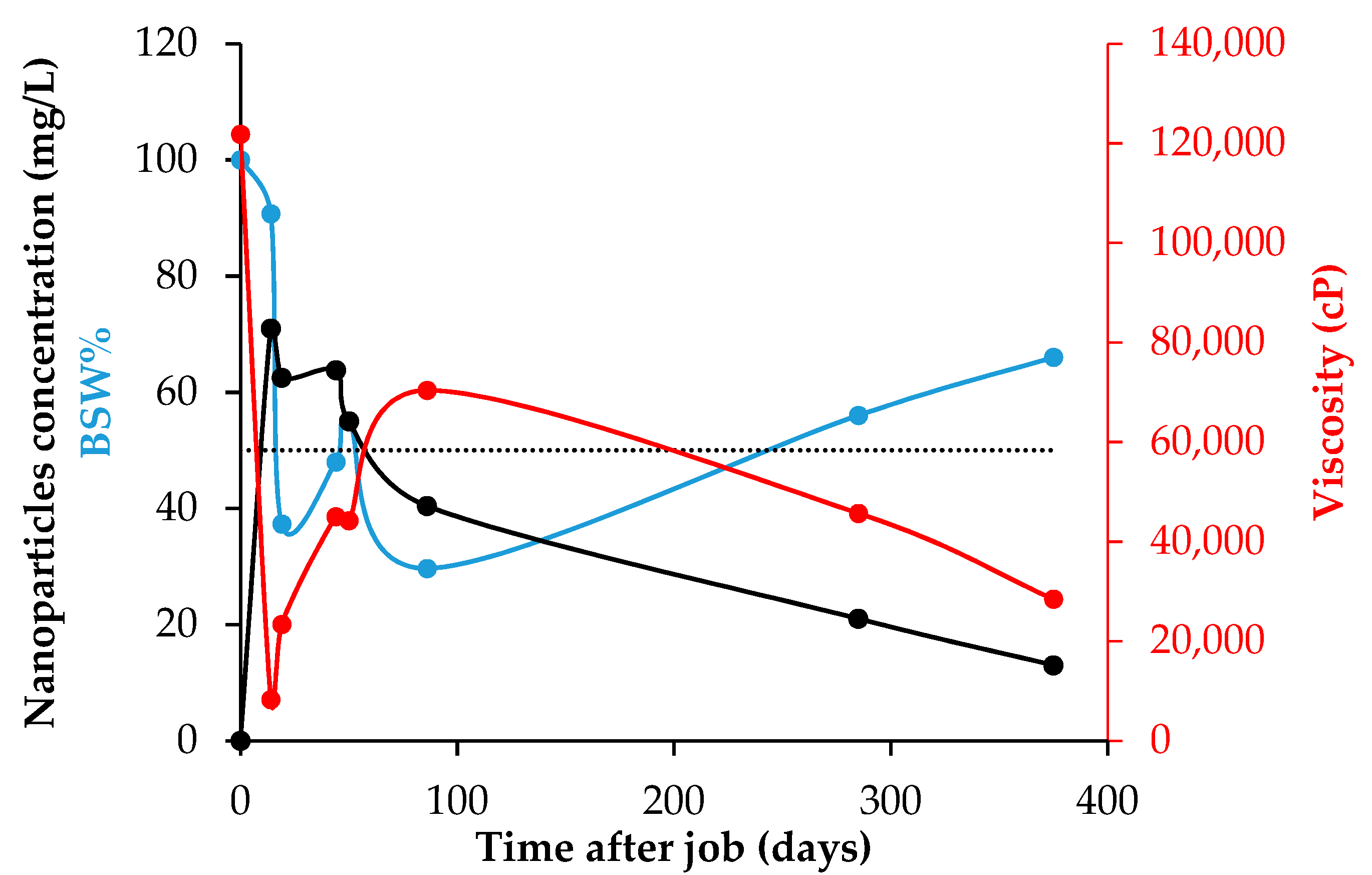
| Sample | Core | Carbolite Porous Media |
|---|---|---|
| Length (cm) | 6.8 ± 0.1 | 7.2 ± 0.1 |
| Diameter (cm) | 3.7 ± 0.1 | 3.8 ± 0.1 |
| Porosity (%) | 21.8 ± 0.2 | 26.4 ± 0.2 |
| Effective permeability to water (mD) | 14.5 ± 0.2 | 477 ± 3 |
| Effective permeability to oil (mD) | 1372 ± 4 | 13,995 ± 9 |
| Order | Additive | Dosage % v/v |
|---|---|---|
| 1 | Bactericide | 0.005 |
| 2 | Clay stabilizer | 0.200 |
| 3 | Guar gum-based polymer | 0.875 |
| 4 | Surfactant | 0.200 |
| 5 | Zeta Potential Modifier | 1.500 |
| 6 | pH controller | 0.400 |
| 7 | Delayed breaker | 0.400 |
| 8 | Peroxide breaker | 0.100 |
| 9 | Metaborate crosslinker | 480 mg/L |
| Nanoparticle | dp-50 ± 0.2 nm | SBET ± 1 m2/g | Total Acidity ± 0.02 mmol/g | Isoelectric Point ± 0.03 (pH) |
|---|---|---|---|---|
| Si07 | 11.6 | 388 | 2.16 | 2.40 |
| Si07A | 12.9 | 216 | 2.85 | 2.05 |
| Si07B | 13.4 | 143 | 1.29 | 2.25 |
| Si200 | 37.2 | 303 | 1.99 | 2.35 |
| Si200A | 39.7 | 182 | 2.91 | 1.95 |
| Si200B | 43.1 | 106 | 1.46 | 2.05 |
| Al | 95.0 | 103 | 0.61 | 9.70 |
| Al-A | 97.2 | 76 | 0.77 | 6.42 |
| Al-B | 97.4 | 62 | 0.59 | 7.38 |
| Parameter | HO | Si07 100 ppm | Si07 1000 ppm | Si200 100 ppm | Si200 1000 ppm | Al 100 ppm | Al 1000 ppm |
|---|---|---|---|---|---|---|---|
| µ(∞,γ) (cP) | 21,497.76 | 20,953.69 | 18,617.21 | 21,884.76 | 21,157.80 | 21,701.18 | 21,698.76 |
| µ(0,γ) (cP) | 87,857.79 | 85,926.09 | 77,621.58 | 86,881.78 | 86,044.27 | 86,847.72 | 84,335.92 |
| αc (s) | 0.0205 | 0.0213 | 0.0202 | 0.0209 | 0.0210 | 0.0209 | 0.0217 |
| m | 2.55 | 2.36 | 2.33 | 2.61 | 2.61 | 2.65 | 2.67 |
| RSME% | 3.74 | 4.78 | 4.13 | 4.88 | 4.86 | 4.38 | 4.47 |
| DVR% (@ 10 s−1) | - | 3.41 | 10.95 | 1.24 | 2.42 | 0.26 | 0.61 |
| Parameter | HO | Si07B 1000 ppm | Si07A 1000 ppm | Si200B 1000 ppm | Si200A 1000 ppm | Al-B 1000 ppm | Al-A 1000 ppm |
|---|---|---|---|---|---|---|---|
| µ(∞,γ) (cP) | 21,497.76 | 20,901.40 | 20,519.24 | 21,843.35 | 21,331.19 | 20,486.17 | 21,557.05 |
| µ(0,γ) (cP) | 87,857.79 | 83,590.54 | 82,053.06 | 87,101.90 | 87,267.08 | 85,215.54 | 87,697.57 |
| αc (s) | 0.0205 | 0.0206 | 0.0207 | 0.0205 | 0.0211 | 0.0207 | 0.0208 |
| m | 2.55 | 2.56 | 2.60 | 2.63 | 2.61 | 2.62 | 2.57 |
| RSME% | 3.74 | 3.63 | 4.08 | 4.46 | 4.92 | 4.37 | 4.01 |
| DVR% (@ 10 s−1) | - | 3.69 | 6.50 | 0.89 | 1.27 | 0.81 | 2.76 |
| Shear Rate (s−1) | µ FF (cP) | µ FF + Si07 (cP) | DVR% | µ FF + Si200 (cP) | DVR% | µ FF + Al (cP) | DVR% |
|---|---|---|---|---|---|---|---|
| 25 | 1850 ± 2 | 2406 ± 3 | 30.1 | 3453 ± 3 | 86.6 | 2376 ± 3 | 28.4 |
| 50 | 1332 ± 2 | 1327 ± 2 | 0.4 | 1611 ± 3 | 20.9 | 1521 ± 2 | 14.2 |
| 75 | 998 ± 1 | 1 078 ± 2 | 8.0 | 1184 ± 2 | 18.6 | 1260 ± 2 | 26.3 |
| 100 | 915 ± 1 | 913 ± 1 | −0.2 | 954 ± 1 | 4.2 | 955 ± 1 | 4.4 |
| H (mg/m2) | K (g/g) | q (mg/g) | RSME% |
|---|---|---|---|
| 0.037 | 0.072 | 5.75 | 3.99 |
Publisher’s Note: MDPI stays neutral with regard to jurisdictional claims in published maps and institutional affiliations. |
© 2022 by the authors. Licensee MDPI, Basel, Switzerland. This article is an open access article distributed under the terms and conditions of the Creative Commons Attribution (CC BY) license (https://creativecommons.org/licenses/by/4.0/).
Share and Cite
Giraldo, M.A.; Zabala, R.D.; Bahamón, J.I.; Ulloa, J.M.; Usurriaga, J.M.; Cárdenas, J.C.; Mazo, C.; Guzmán, J.D.; Lopera, S.H.; Franco, C.A.; et al. Development and Evaluation from Laboratory to Field Trial of a Dual-Purpose Fracturing Nanofluid: Inhibition of Associated Formation Damage and Increasing Heavy Crude Oil Mobility. Nanomaterials 2022, 12, 2195. https://doi.org/10.3390/nano12132195
Giraldo MA, Zabala RD, Bahamón JI, Ulloa JM, Usurriaga JM, Cárdenas JC, Mazo C, Guzmán JD, Lopera SH, Franco CA, et al. Development and Evaluation from Laboratory to Field Trial of a Dual-Purpose Fracturing Nanofluid: Inhibition of Associated Formation Damage and Increasing Heavy Crude Oil Mobility. Nanomaterials. 2022; 12(13):2195. https://doi.org/10.3390/nano12132195
Chicago/Turabian StyleGiraldo, María A., Richard D. Zabala, Jorge I. Bahamón, Juan M. Ulloa, José M. Usurriaga, José C. Cárdenas, Camilo Mazo, Juan D. Guzmán, Sergio H. Lopera, Camilo A. Franco, and et al. 2022. "Development and Evaluation from Laboratory to Field Trial of a Dual-Purpose Fracturing Nanofluid: Inhibition of Associated Formation Damage and Increasing Heavy Crude Oil Mobility" Nanomaterials 12, no. 13: 2195. https://doi.org/10.3390/nano12132195
APA StyleGiraldo, M. A., Zabala, R. D., Bahamón, J. I., Ulloa, J. M., Usurriaga, J. M., Cárdenas, J. C., Mazo, C., Guzmán, J. D., Lopera, S. H., Franco, C. A., & Cortés, F. B. (2022). Development and Evaluation from Laboratory to Field Trial of a Dual-Purpose Fracturing Nanofluid: Inhibition of Associated Formation Damage and Increasing Heavy Crude Oil Mobility. Nanomaterials, 12(13), 2195. https://doi.org/10.3390/nano12132195








